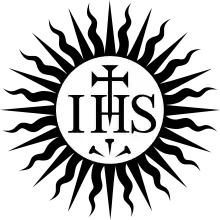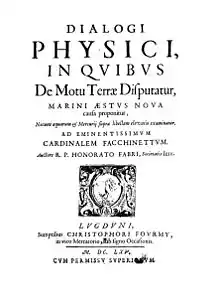Honoré Fabri
Honoré Fabri (Honoratus Fabrius; 15 April 1608 – 8 March 1688) was a French Jesuit theologian. He was a mathematician, physicist and controversialist.[1][2]
Honoré Fabri | |
|---|---|
 | |
| Born | April 15, 1608 |
| Died | March 8, 1688 (aged 79) |
| Nationality | French |
| Occupation | Mathematician, physicist, Jesuit theologian, controversialist |
| Part of a series on the |
| Society of Jesus |
|---|
 |
| History |
| Hierarchy |
| Spirituality |
| Works |
| Notable Jesuits |
|
|
Life
He entered the Society of Jesus at Avignon, in 1626. For eight years he taught philosophy and for six years mathematics at the Jesuit college at Lyons, attracting many pupils. Called to Rome, he became the theologian of the court of the papal penitentiary in the Vatican basilica, a position he held for thirty years.[1][2]
Fabri was a highly respected scientist among his contemporaries. He was elected to the Accademia del Cimento in 1657, the year the Academy was founded.[1] Leibniz placed him with Galileo, Torricelli, Steno and Borelli for his work on elasticity and the theory of vibrations, and alone with Galileo for his efforts to 'rationalise experimental kinematics'. Mersenne rated him 'a veritable giant in science'[3]
Works

Sommervogel mentions thirty-one titles of published works in connection with Fabri's name, besides fourteen of his productions in manuscript, in the Library of Lyons.
The following are the more important of his publications:
- Tractatus physicus du motu locali (1646).
- Metaphysica Demonstrativa, Sive Scientia Rationum Universalium (Lyon, 1648).
- Pithanophilus, seu dialogus vel opusculum de opinione probabili, etc. (Rome, 1659).
This work was attacked by Stephanus Gradius, Prefect of the Vatican Library, in his Disputatio de opinione probabili (Rome, 1678; Mechlin, 1679).
- Honorati Fabri, Societatis Jesu, apolgeticus doctrinæ moralis ejusdem Societatis, (Lyons, 1670; Cologne, 1672).
This treats, in eleven dialogues, of probabilism, explaining its true nature, and refuting the charges of its opponents. The Cologne edition was considerably enlarged but did not meet with ecclesiastical approbation; it was placed on the Index of forbidden books soon after its appearance.
- Una fides unius Ecclesiæ Romanæ contra indifferentes hujus sæculi tribus librus facili methodo asserto, (Dillingen, 1657).
- Summula theologica in quâ quæstiones omnes alicujus momenti, quæ a Scholasticus agitari solent, breviter discutiuntur ac definiuntur, (Lyons, 1669).
The principles on which this work constructs its theological conclusions are far different from those of Aristotle.
- Euphiander seu vir ingeniosus, (Lyons, 1669; Vienna, 1731; Budapest, 1749; Ofen, 1763).
Most of Fabri's other works deal with philosophy, mathematics, physics, astronomy, and even zoology. In his treatise on man he claims to have discovered the circulation of the blood, prior to William Harvey, but after having investigated this question, Father fr:Auguste Bellynck arrives at the conclusion that, at best, Father Fabri may have made the discovery independently of Harvey.[1][4]
See also
- List of Roman Catholic scientist-clerics
References
- Honoré Fabri. www-history.mcs.st-andrews.ac.uk
- Elazar, Michael (2011). Honoré Fabri and the Concept of Impetus: A Bridge between Conceptual Frameworks: A Bridge Between Conceptual Frameworks. Springer. pp. 5–. ISBN 978-94-007-1605-6.
- John L. Heilbron, Electricity in the 17th and 18th centuries: A study of early modern physics. Univ of California Press, 1979. p. 195.
- cf. Bellynck (1864) Cours de Zoologie, p. 23.
Further reading
- Sommervogel, Bibl. de la C. de J. (Brussels and Paris, 1892), III, 511–521;
- Hugo von Hurter, Nomenclator Literarius (Innsbruck 1893), tom. II, 598–600.
- Palmerino, Carla Rita, "Fabri, Honoré (c. 1608–1688)", in : Dictionary of Seventeenth Century French Philosophers, ed. Luc Foisneau, London – New York : Thoemmes – Continuum, 2008, vol. I, 453–460
External links
- Catholic Encyclopedia article
- Honoré Fabri, S.J. (1607 to 1688) and his post-calculus geometry
- MacTutor page
- Galileo Project page
- Honoré's (1667) Synopsis optica - digital facsimile from the Linda Hall Library
![]() This article incorporates text from a publication now in the public domain: Herbermann, Charles, ed. (1913). "Honoré Fabri". Catholic Encyclopedia. New York: Robert Appleton Company.
This article incorporates text from a publication now in the public domain: Herbermann, Charles, ed. (1913). "Honoré Fabri". Catholic Encyclopedia. New York: Robert Appleton Company.